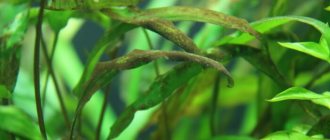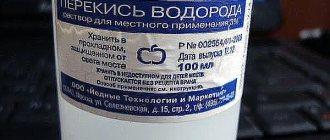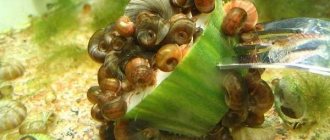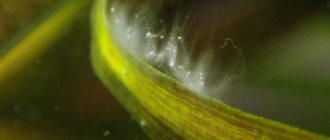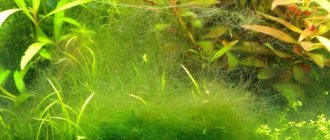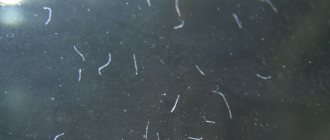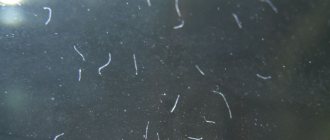In most cases, algae causes a negative reaction in aquarists. They look untidy and spoil the appearance of the composition. At the same time, not all plants are an integral part of living nature. They live in the surface waters of the planet. It is from them that the existence of most aquatic ecosystems begins. However, an aquarium is a biocenosis and not a natural body of water. It is supported artificially. Filamentous algae, like all other species, settle here independently. These are lower algae, and they do more harm than good.
Description and types of filamentous algae in the aquarium, how to recognize
Filament is represented by a wide variety of species. Each of them must be dealt with individually. If it is possible to determine the specific type of parasite, this will allow us to quickly move on to its immediate elimination.
The main algae are:
- Edogonium. A classic example of filamentous algae. Externally, the shape resembles a fluffy green ball. The appearance of this plant indicates a lack of useful elements in the aquarium.
- Cladophora. The parasite looks like long threads. With an excess amount of microelements and impaired water circulation, it develops rapidly and rapidly.
- Spirogyra. Floating algae get along well with other plants and are able to adapt to any living conditions. They quickly fill the free space, the plant is slippery to the touch, the leaves are easily rubbed with your hands.
- Rhizoclonium. Looks like a cladophora. If its spores are present in the aquarium, it quickly makes itself felt, usually after the first start of the aquarium. At the same time, there is no particular threat emanating from him.
If filament appears in the aquarium, this indicates improper care of it. Even if it looks beautiful, you should get rid of it quickly. The algae got its name because it is formed by long and small threads, presented in large quantities. They are usually green in color. It is worth distinguishing them from brown and black algae, which appear for the same reasons.
How to distinguish them:
- plants consist of thin green threads;
- their texture is slippery and soft;
- If you take such a plant out of the water, it will become deformed.
Fighting methods
Filamentous algae will certainly appear in a reservoir if there is an excess content of water-soluble nitrogen and phosphorus compounds. Therefore, first of all you need to pay attention to the operation of the filter and lighting. Blue light, which favors the growth of filament, must be eliminated and replaced with soft light.
The accumulation of ammonia compounds occurs both when the filter is clogged and when there are too many fish and not enough plants. Floating plants and those that grow quickly (hygrophiles, Vallisneria) inhibit filamentous algae, depriving them of nutrition. The concentration of iron in the aquarium is of great importance. It should not exceed the permissible dose of 0.2 mg/l.
Removing algae from the aquarium by hand, for example when infesting with Spirogyra, is almost the only method of control. It is very important to clean the plants from threads and wash them, and add CO2 to the aquarium only during the daytime. In addition to all cleaning activities, many recommend darkening the aquarium for three days.
In some cases, the use of algaecides, such as Sidex, containing glutaraldehyde, is very effective. Hydrogen peroxide in an amount of 6 to 10 mg/l and filamentous solution are also incompatible.
Biological methods of destroying parasitic algae should not be neglected. Those who eat filament are catfish, gastromyzons, viviparous fish, platies and mollies, as well as carp, jordanella, and Siamese epalceorhynchos.
Reasons for the appearance of filament in an aquarium
There are many varieties of filamentous algae. Almost all aquarists have to deal with this phenomenon.
The main reasons for the appearance of the parasite are:
- Excessive lighting. If the aquarium is exposed to sunlight or regularly lit by artificial lamps, the likelihood of algae growth increases.
- Insufficient aeration. Oxygen is required by all living organisms. With a lack of air, stagnation occurs, which is why algae appear.
- Lack of plants. If there are few of them in the aquarium, over time the balance is disrupted and a large amount of microelements accumulates. A favorable environment for the growth of the parasite appears.
- Increased amount of nitrates, phosphates, ammonia. Lack of cleaning combined with improper care leads to such phenomena.
- Migrant plants. Filamentous spores sometimes end up in the aquarium along with other algae or decorative objects.
- Large amount of iron. This phenomenon occurs when there are metal objects in the water.
The problem is encountered if the owner does not promptly clean the container from lumps of food or is inattentive to the equipment of the container.
Any actions should be carried out step by step. Algae appear in the reservoir first. If they take root, a favorable atmosphere is formed in it. If already during this period the growth of filamentous algae is noticeable, the aquarium will need to be restarted.
Where do filamentous algae grow?
Filament algae in an aquarium can form on decorative objects or on other plants. They can be found in almost any place.
It can be:
- water heater;
- filter;
- plants;
- driftwood.
The parasite can fill all available space and has a tendency to spread quickly. It feeds on substances present in water. It is also helped in its growth and development by photosynthesis, which occurs in the light.
It is important to detect threadworm in a timely manner, since inaction can lead to the death of the remaining inhabitants of the tank.
Description
Filamentous algae (Green Hair Algae, Hair/Thread Algae, Fuzz Algae) is a collective term (not directly related to taxonomy) that unites many genera of green algae that have filamentous (trichal) or, partly, heterotrichous (heterotrichous) organization of their body (thallus). Occupying the maximum possible space and enveloping aquarium plants, filament deprives them of access to food and lighting, which gradually leads to degradation and death of the plants.
Why do filamentous algae reproduce quickly?
If the filament has just appeared in the aquarium, it itself is unlikely to disappear. If the conditions of detention do not change, then it will actively grow. Lighting is of key importance here. It is enough to shade the aquarium to curb its growth, but you will still have to clean all surfaces. That is, the main reason for the rapid growth of algae is particularly favorable conditions. Often it is enough to remove all these factors and algae growth will stop. To remove existing threads, you will have to do cleaning and treatment with drugs.
Why is filament dangerous for fish and aquariums?
Tufts of filamentous green algae may form on clusters of filamentous green algae. They are attached to snags, enveloping the equipment inside the reservoir, as well as other plants.
If such algae is present in small quantities, there is no need to worry. If there are too many of them, serious problems are likely.
The potential harm caused by filament is as follows:
- Algae residues are a source of toxic substances that have a negative impact on the inhabitants of the reservoir. Gradually the plants die and begin to decompose. This provokes environmental pollution.
- Algae interferes with the full growth of other plants by entwining them. Residues of food can get into the web, which further contributes to the spread of contamination. Small and adult fish can become entangled in the bunches.
- Parasites spoil the aesthetic appearance of the tank, as the water in it becomes cloudy.
Signs of thread
The appearance of filaments is accompanied by the formation of slightly noticeable green threads. As they reproduce, they gather in bunches, accumulating on plants, ground stones, decorative elements and in other well-lit places. The spread of the parasite is very fast - it can fill a reservoir in a matter of days. The water in the aquarium becomes cloudy and greenish in color. An unpleasant, musty odor may appear. If the parasite spreads significantly, the death of fish and plants cannot be ruled out.
How to get rid of string algae
Before you take active action, you need to determine why the green tufts appeared. After eliminating the main factor that provokes the growth of these organisms, you can achieve victory over the filament. First of all, it is necessary to destroy the algae. The cleaner the pond, the better.
Use magnetic graters and scrapers. But the best thing is a dishwashing sponge. Driftwood, filters and decorative elements can be washed well with it. To do this, use an old toothbrush. It is ideal for this procedure, as it is small in size and equipped with stiff bristles. It can be used to disinfect even hard-to-reach areas.
To get rid of filamentous algae in an aquarium, specialized products or algaecides are used, among which the most widespread are:
- Sidex;
- ApiAlgafix;
- Tetra Algesit.
The drugs are dissolved in a small amount of water. The dose depends on the degree of filamentous growth. In case of severe infection, it is worth repeating the treatment after a week. The same formulations can also be used for prophylaxis with a low dosage.
There are other methods to solve the problem. Hydrogen peroxide is effective against filamentous bacteria. It is permissible to use no more than 40 ml of this product per 100 liters of water. They draw it into a syringe and direct it to the area where the parasitic plant is located. Peroxide does not have a negative effect on fish and other inhabitants of the aquarium.
It is impossible to figure out how to deal with filamentous algae in an aquarium until the condition of the aquarium is analyzed. Getting rid of the pest is not easy. Even a small thread can quickly spread and fill the entire space.
But by following simple recommendations, you will be able to solve this problem. When selecting plants for a future aquarium, as well as decorative decorations, you should carefully inspect them before placing the tank. There may already be threads on them, and they need to be quickly removed.
For higher plants, a comfortable environment should be created. If for some reason this is not possible, you will have to resort to the use of specialized compounds or fertilizers. They strengthen plants and reduce the risk of thread overgrowth. High-quality aeration is very important for the supply of oxygen to all inhabitants of the aquarium. The amount of nitrates and phosphates should be adjusted.
It is also important to monitor the lighting. Let's allow the light regime to be no more than 8 hours a day. It is better to move the aquarium, which is located in a sunny place. Additionally, it can be shaded. Feed volumes should also be reduced. It is better to give it gradually so that pieces of food do not remain in the container.
Advice from experienced aquarists
The methods presented above for dealing with threadworm are undoubtedly effective, but do not guarantee that the problem will not arise in the future. Experienced aquarists recommend creating a regime in the aquarium in which conditions for the proliferation of algae would become impossible.
Balance of nitrates and phosphates in water
The most effective measure is to maintain acceptable levels of nitrates and phosphates in water. These substances are necessary to maintain the balance of the ecosystem. However, over time, their quantity becomes too high, so the water must be changed once a week. Naturally, not all, but about a third of the total volume.
In some areas the water is very hard. It can also harm fish and plants, so nitrate levels should be tested regularly. This figure should not exceed 20 mg/l.
Reducing light intake
The filament needs light to grow, but it does not appear in the shade. An effective way to eliminate it is to reduce the amount of light entering the aquarium. To do this, use dim lamps and prevent the tank from being illuminated around the clock.
Normalization of carbon dioxide intake
Filamentum is an unpretentious algae and can grow and develop in conditions that higher plants cannot tolerate, for example, with a deficiency of carbon dioxide. It is necessary to maintain the content of this substance at a level acceptable for plants, since most of them are able to suppress the spread of algae.
Natural enemies of filamentous algae
Filamentum is a soft algae, so it is well eaten by Amano shrimp. Barbus are also not averse to profiting from plants. On glass and stones, a good effect can be achieved using a Neretina snail. Of course, if the entire aquarium is overgrown with algae, algae eaters are unlikely to help, but with local lesions, when the problem is noticed at the very beginning, they can be very effective.
It is worth noting that barbs can bite the fins of other inhabitants of the aquarium. Amano, on the other hand, are friendly, but they themselves can be eaten by some predatory fish. Neretinas are the most unpretentious, they don’t even need to be fed, so they are especially often used to combat algae. Speaking of feeding, if barbs, shrimp or snails are full, they will not eat algae, so you need to keep them without food before introducing them into an aquarium with filamentous fish.
Lamellar multicellular green algae
Lamellar multicellular green algae live in the seas. They can reach a length of up to half a meter. They are characterized by attachment to the substrate.
- Ulva
A lamellar multicellular green algae, the thallus of which imitates a leaf structure. The structure of the ulva is more complex than that of the filamentous ulotrix, but their life cycles are similar. A haploid zoospore with flagella also grows into a filament, the cells of which divide in several directions. As a result, a leaf-like structure is formed. The cells at the base of the algae form rhizoid-like outgrowths.
Rice. 10. Reproduction of Ulva
The life cycle of Ulva is characterized by alternation of isomorphic generations. Gametophyte and sporophyte are similar in appearance. During the sexual process, gametophyte cells form anisogametes with two flagella. When gametes (n) fuse, a zygote (2n) develops. Then a filament and a leaf-shaped thallus are formed from it, like a gametophyte.
Prevention of filamentous algae
You won’t have to think about how to get rid of filament in an aquarium if you follow the general recommendations. Preventive measures include timely cleaning of the soil and changing water. A large amount of fish waste settles at the bottom. If they are not removed in a timely manner, rotting processes begin and the concentration of nitrates will exceed all permissible standards. After cleaning, it is advisable to replace approximately 30% of the water with new water. You cannot completely change the water. This is dangerous for the inhabitants of the aquarium; some species may die, especially shrimp. It is correct to carry out the replacement over several days, and 1/7-1/5 of the entire volume is drained at a time. Then the level of substances will not be greatly disturbed and the fish will not suffer.
It is important to monitor the structure of the soil, control the normal level of water acidity, and avoid bright lighting during the treatment period. Typically, it will last several weeks depending on the amount of algae.
It is better to place the aquarium in a lighted place, but without access to direct sunlight. Fill the tank with plants. If there are enough of them, algae will not be able to actively reproduce. Regular feeding of plants contributes to their strengthening and intensive growth. There is also a simultaneous negative effect on filament.
When the natural environment of the aquarium is balanced, algae do not harm, but play the role of a participant in biological processes. In small quantities, they absorb excess nutrients and products formed as a result of putrefactive processes. This is why aquarists prefer to place algae in the most secluded places. But there should be a minimum number of them. Thanks to this, the tank will look harmonious and make a favorable impression.
Ways to combat filament
Slimy long threads in an aquarium are an unpleasant sight, upon seeing which every aquarist strives to free the tank from harmful guests. It should be noted that the thread is very tenacious and grows rapidly - even a tiny green thread can ultimately cause an algal riot. To save your pets and plants from the toxic waste produced by pests, you need to know methods for eliminating slimy aquatic grass. Filament in the aquarium - how to fight:
- The first thing an aquarist should do when noticing green strands in an aquarium is to identify the cause of the development of an algal outbreak and eliminate the unfavorable factor. If the light intensity and indicators of the aquatic environment are normal, it means that the filament has penetrated from the outside - along with new plants, water or food.
- Since filamentous plants compete with higher species of flora for food, you should increase the chances of plants by organizing suitable conditions for flowers. Plants will take nutrients from the water, leaving the grass “hungry.”
- The filament in the aquarium loves light very much, so you can slow down the formation and reproduction of algae by reducing the duration of daylight hours to 7-8 hours.
- Mechanical cleaning of the aquarium will help to partially remove green balls of thread. To do this, experienced aquarists remove green guests using a net with a fine mesh.
- In addition to mechanical cleaning, some of the threads will be removed by algae-eating fish or Amano shrimp. If these cleaners are put into a tank when hungry, they will happily eat harmful grass.
- One of the best drugs developed to combat green pests is the drug Sidex. This product is used according to the instructions included with the drug.
